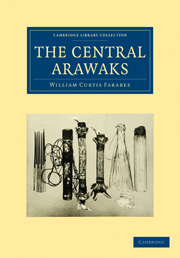Summary
The Mapidians (Maopityans or Moonpidennes) call themselves Pidians, people, but the Wapisianas who have been the guides to their country have prefixed ma-, not, hence they are not people to all travelers who come from the west.
Schomburgk was the first to visit them in 1843, when he found the whole tribe, thirty-nine in all, living in one village at the head of the Apiniwau River on the Brazilian side of the Akarai mountains adjoining the Tarumas on the Guiana side. Coudreau visited them in 1884 and apparently they were still occupying the same territory, but some of them had moved across to the Taruma country. Im Thurn, who did not visit them, says they lived among the Tarumas and spoke the same language.
Today they live farther in the interior, surrounded by tribes of Carib stock, among whom they are intermarrying and from whom they are receiving new elements of culture. They claim relationship with the Atarois, but speak their own language, which is a dialect of Arawak resembling the Ataroi to such an extent that our Ataroi bov recognized it at once. They have a tradition that their ancestors came from the head of the Apiniwau, but no one lives on that river today. The Atarois have a tradition that a part of their tribe in ancient times went over the mountains to the southeast and disappeared.
- Type
- Chapter
- Information
- The Central Arawaks , pp. 158 - 164Publisher: Cambridge University PressPrint publication year: 2009First published in: 1918



